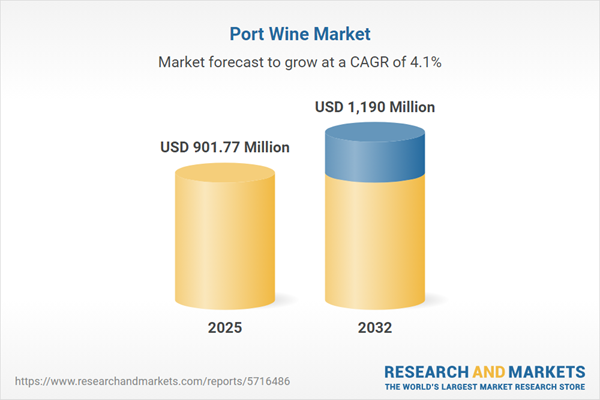Speak directly to the analyst to clarify any post sales queries you may have.
Port Wine stands as a unique fortified wine recognized for its historical heritage, evolving production techniques, and increasing relevance across global markets. Leading producers and innovative entrants are leveraging both tradition and new consumer engagement strategies to reinforce market growth and appeal to the changing demands of premium beverage segments.
Port Wine Market Snapshot
The Port Wine market grew from USD 866.33 million in 2024 to USD 901.77 million in 2025. Driven by a CAGR of 4.08%, it is projected to reach USD 1.19 billion by 2032. This trajectory reflects robust sector confidence, underpinned by heritage, innovation, and dynamic shifts in regional consumption and trade. Resilience amid regulatory changes and the premiumization trend underpin sustained value creation for stakeholders.
Scope & Segmentation
This report provides a comprehensive analysis across product categories, distribution channels, price levels, aging profiles, closure types, and all major regional submarkets, serving as a reference for strategic planning.
- Product Types: Late Bottled Vintage, Rosé, Ruby, Tawny, Vintage, White
- Distribution Channels: Off-Trade (Online, Specialty Stores, Supermarkets), On-Trade (Bars, Hotels, Restaurants)
- Price Ranges: Economy, Premium, Standard, Super Premium
- Age Categories: Ten-Year, Twenty-Year, Thirty-Year, Forty-Year and Above
- Closure Types: Cork, Screw Cap, Synthetic
- Regions: Americas (United States, Canada, Mexico, Brazil, Argentina, Chile, Colombia, Peru), Europe (United Kingdom, Germany, France, Russia, Italy, Spain, Netherlands, Sweden, Poland, Switzerland), Middle East (United Arab Emirates, Saudi Arabia, Qatar, Turkey, Israel), Africa (South Africa, Nigeria, Egypt, Kenya), Asia-Pacific (China, India, Japan, Australia, South Korea, Indonesia, Thailand, Malaysia, Singapore, Taiwan)
- Companies Profiled: Symington Family Estates (SGPS), S.A.; Sogrape Vinhos, S.A.; Sogevinus Fine Wines, S.A.; Taylor, Fladgate & Yeatman, S.A.; Ramos Pinto & Cª, S.A.; Fonseca Guimaraens, S.A.; Niepoort & Cª, Lda.; Wiese & Krohn, S.A.; Real Companhia Velha, S.A.; Sociedade Agrícola Quinta do Noval e Lagar do Cervo, Lda.
Key Takeaways
- Port Wine is defined by its intricate blend of heritage, geography, and innovation, maintaining strong appeal among collectors and new market entrants alike.
- Premiumization is expanding market reach, with consumers showing heightened interest in limited editions, aged expressions, and artisanal blends across multiple regions.
- Digital transformation, e-commerce adoption, and enhanced storytelling through social media are accelerating category awareness and enabling direct-to-consumer access for boutique producers.
- Sustainability initiatives, including organic and biodynamic practices and eco-efficient operations, are increasingly central to product differentiation and long-term market positioning.
- Strategic alliances with on-trade partners and targeted market education are elevating brand visibility in high-value hospitality environments and among emerging consumer segments.
- Flexible channel strategies are essential to accommodate regional preferences, navigate evolving regulatory environments, and drive growth in both legacy and emerging markets.
Tariff Impact on Port Wine Distribution
Recent tariff adjustments in the United States have reshaped cost structures and supply chain strategies for market participants. Importers and distributors are adjusting pricing, inventory management, and logistics routing to address higher duties and protect market shares. Producers are also deploying value-added services—such as custom packaging and subscription models—and adjusting their collaborative approaches with regional partners to sustain accessibility across multiple price points and consumer tiers.
Methodology & Data Sources
Research for this Port Wine market analysis integrates primary interviews with industry executives, sommeliers, and supply chain stakeholders, alongside systematic secondary reviews of trade periodicals, regulatory filings, and channel audits. Quantitative findings are validated using competitive benchmarking, trend analysis, and scenario modeling for robust conclusions.
Why This Report Matters
- Enables informed portfolio management and marketing strategy tailored to shifting consumer expectations.
- Supports data-driven decision-making by providing regionally differentiated insights on channel trends and regulatory impacts.
- Empowers proactive risk mitigation and growth planning by highlighting key market drivers and competitive dynamics.
Conclusion
Port Wine’s future is shaped by the interplay of established heritage, new consumer dynamics, and adaptive strategies among stakeholders. This report equips leaders to refine their approach in response to industry challenges and evolving market opportunities.
Additional Product Information:
- Purchase of this report includes 1 year online access with quarterly updates.
- This report can be updated on request. Please contact our Customer Experience team using the Ask a Question widget on our website.
Table of Contents
3. Executive Summary
4. Market Overview
7. Cumulative Impact of Artificial Intelligence 2025
List of Figures
Companies Mentioned
The companies profiled in this Port Wine market report include:- Symington Family Estates (SGPS), S.A.
- Sogrape Vinhos, S.A.
- Sogevinus Fine Wines, S.A.
- Taylor, Fladgate & Yeatman, S.A.
- Ramos Pinto & Cª, S.A.
- Fonseca Guimaraens, S.A.
- Niepoort & Cª, Lda.
- Wiese & Krohn, S.A.
- Real Companhia Velha, S.A.
- Sociedade Agrícola Quinta do Noval e Lagar do Cervo, Lda.
Table Information
| Report Attribute | Details |
|---|---|
| No. of Pages | 181 |
| Published | October 2025 |
| Forecast Period | 2025 - 2032 |
| Estimated Market Value ( USD | $ 901.77 Million |
| Forecasted Market Value ( USD | $ 1190 Million |
| Compound Annual Growth Rate | 4.0% |
| Regions Covered | Global |
| No. of Companies Mentioned | 11 |









